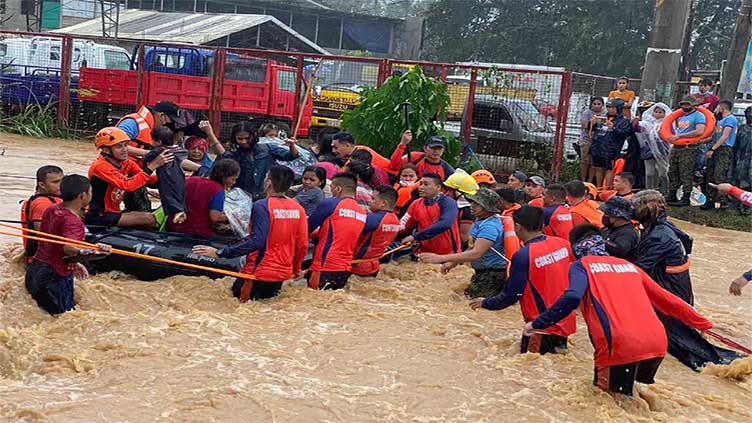12 dead as powerful typhoon batters the Philippines

World
At least 12 people have died in the strongest typhoon to hit the Philippines on Friday.
CEBU (AFP) - At least 12 people have died in the strongest typhoon to hit the Philippines this year, the disaster agency said Friday, after the storm swept across the archipelago uprooting trees, toppling power poles and flooding villages.
More than 300,000 people fled their homes and beachfront resorts as Typhoon Rai pummelled the southern and central regions of the country, knocking out communications in some areas and tearing roofs off buildings.
Rai was a super typhoon when it slammed into Siargao Island on Thursday, packing maximum sustained winds of 195 kilometres an hour (120 miles). On Friday, wind speeds eased to 150 kilometres an hour, the state weather forecaster said.
"Siargao island is heavily damaged," Ricardo Jalad, executive director of the national disaster agency, told a briefing.
Jalad said 12 people have been reported killed during the storm, which lashed the popular tourist destination of Palawan island after ravaging the Visayas and the southern island of Mindanao.
Another seven have been reported missing and two injured, he added.
"We are seeing people walking in the streets, many of them shell-shocked," ABS-CBN correspondent Dennis Datu reported from the hard-hit city of Surigao, which is on the northern tip of Mindanao and near Siargao.
"All buildings sustained heavy damage, including the provincial disaster office. It looks like it s been hit by a bomb."
Datu said the main roads leading into the coastal city had been cut off by landslides, fallen trees and toppled power poles.
More than 300,000 people had sought emergency shelter as the typhoon charged across the Pacific Ocean and smashed into the country, the agency said. About 18,000 had yet to return home.
"The full picture is only just starting to emerge, but it is clear there is widespread devastation," said Alberto Bocanegra, head of the International Federation of Red Cross and Red Crescent Societies in the Philippines.
Communications were still down in Siargao, which took the brunt of the storm, and Bocanegra said the organisation had "grave fears" for people there.
Philippine Coast Guard shared photos on social media showing widespread destruction with roofs torn off buildings, wooden structures shattered and palm trees stripped of fronds around Surigao.
Aerial footage showed swathes of rice fields under water.
Surigao City Mayor Ernesto Matugas told ABS-CBN that Rai ravaged the city of around 170,000 people for several hours, causing "severe" damage.
"The wind was very strong," Matugas said.
"Everything sustained damage -- roofs blown off, access roads blocked by landslides."
Officials from the national disaster agency said earlier that initial reports suggested the overall damage was "not that massive" and they were not expecting "many casualties".
"The damage was not as big as compared to previous typhoons of the same strength," Casiano Monilla, the deputy administrator for operations, told a briefing.
Scores of flights were cancelled across the country and dozens of ports temporarily closed as the weather bureau warned several-metre-high storm surges could cause "life-threatening flooding" in low-lying coastal areas.
The country s second busiest airport in Cebu was damaged and flights have been suspended, Jalad said.
"The devastation is hard to explain," said Joel Darunday, 37, a tour operator in the central island province of Bohol, who was hunkered down at home with his family when the storm ripped off the roof.
"It was very strong. The last time I experienced something like this was back in the 1980s."
- Clean-up begins -
People began clearing fallen trees, branches and debris from roads as clean-up efforts and relief operations got underway in areas hit by Rai.
Verified photos taken in Lapu-Lapu city in Cebu province showed roadside buildings flattened by the storm, while sheets of corrugated iron roofing littered streets.
Some wooden houses in the coastal town of Dulag in Leyte province were destroyed, while uprooted coconut trees lay on the beach.
"We were afraid," said Ced Golingay, 31, a hotel receptionist in the central city of Iloilo who lives with her parents.
"Even in my sleep I could feel the wind lashing the house."
Rai, locally named Odette, is hitting the Philippines late in the typhoon season -- most cyclones typically develop between July and October.
Scientists have long warned that typhoons are becoming more powerful and strengthening more rapidly as the world becomes warmer because of human-driven climate change.
Rai moved across the Visayas region to Palawan on Friday and was expected to emerge Saturday over the South China Sea, heading towards Vietnam.
The Philippines -- ranked as one of the world s most vulnerable countries to the impacts of climate change -- is hit by an average of 20 storms and typhoons every year, which typically wipe out harvests, homes and infrastructure in already impoverished areas.


